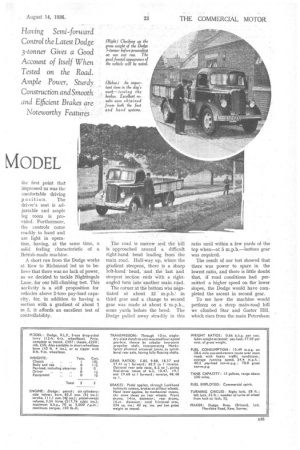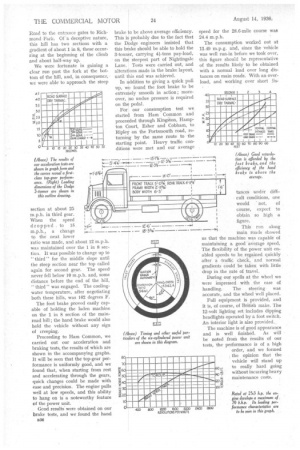A Worthy Addition
Page 40

Page 41

Page 42

If you've noticed an error in this article please click here to report it so we can fix it.
to the Dodge Range
A NEW 3-TON
MODEL
Having Semi -forward Control the Latest Dodge 3-tonner Gives a Good Account of Itself When Tested on the Road. Ample Power, Sturdy Construction and Smooth and Efficient Brakes are Noteworthy Features IN April last, Dodge Bros. (Britain), Ltd., announced a new programme of goods vehicles, all of which were designed and built in this country. The adoption of this policy of marketing, in Great Britain, a full range of machines having no American counterpart followed the successful results obtained with the
4-tonner introduced in May of last year.
In June, 1935, when we published a road-test report of ' the 4-tonner, we expressed the view '„ that the machine would withstand hard usage and maintain its tune over long periods with the minimum of attenti-m. Judging by figures given to us at the Dodge works, it would appear that many operators have come to share our opinion ; a gratifying proportion of the deals recorded by the sales department consists of repeat orders.
An inspection of the latest 34onner shows, at a glance, that it is closely related to the larger model, and it bears little resemblance to the earlier 3-ton machine, which was of transatlantic origin. A road-test report of the last-named appeared in The Commercial Motor dated November 23, 1934. Many of the characteristics revealed in our test of the larger machine are present in the new and smaller model, and the performance is well up to the high standard demanded to-day by operators.
An important feature of the design is the repositioning of the axles to give better load distribution. The front axle has been moved back 7l ins, so that, with the introduction of semi-forward control, the length required behind the axle to accommodate the driver's cab is reduced.
pit4 Furthermore, the load is carried farther within the wheelbase.
Despite the shorter wheelbase, the capacity of the body remains unchanged, and the improved weight distribution reduces the load on the rear springs and tyres. Further, there will be less stress on the engine and transmission, so that important advantages are gained by the new design.
The six-cylindered power unit has a capacity of 3.56 litres and develops its maximum of 70 b.h.p. at 3,000 r.p.m. A study of the detail design of the engine shows that every
effort has been made to combat the causes of wear. Side valves are employed, the inlet valves being made from nickel-chrome steel and the 'exhaust valves from heat-resisting silchrome.
A high-grade grey iron is used for the cylinder block and a special feature of the cooling system is the use of full-length water jackets with spray cooling for the valve ports. The latter is carried out by the use of an internal tube, of deep but narrow section, running the length of the cylinder block. Holes in the tube, opposite each valve port, ensure that these are constantly sprayed with water.
The water pump is easily accessible and a by-pass thermostat enables the engine quickly to warm up after a cold start.
Mention should be made of the care that has been taken to prevent the ingress of dirt into the engine. In addition to a large oil-bath cleaner for the carburetter air intake, filters are provided on the oil filler and on the crankcase breather pipe.
The transmission line follows orthodox practice, and the frame is of sturdy construction, having deep longitudinals (7 1-32 ins.) and wide flanges (2 ins.) ; heavy cross-members are employed.
On the earlier 3-tonner a fivespeed gearbox was incorporated with a close ratio between top and fourth gears. On the present model a fourspeed gearbox has been considered ample for conditions in this country.
On taking over the Dodge for test,
the first point that impressed us was the comfortable driving position. The driver's seat is adjustable and ample leg room is provided. Furthermore, the controls come readily to hand and are light in opera tion, having, at the same time, a solid feeling characteristic of a British-made machine.
A short run from the Dodge works at Kew to Richmond led us to believe that there was no lack of power, so we decided to tackle Nightingale Lane, for our hill-climbing test. This acclivity is a stiff proposition for vehicles above 2-tons pay-load capacity, for, in addition to having a section with a gradient of about 1 in 5, it affords an excellent test of controllability. The road is narrow and the hill is approached around a difficult right-hand bend leading from the main road. Half-way up, where the gradient steepens, there is a sharp left-hand bend, :and the last and steepest 'section ends 'Wvith a rightangled turn into another main Iliad. The corner at the bottom was negotiated at about 12' ra.p.h.1 in third gear and a change to second gear was made at about 6 m.p.h., some yards before the bend. The Dodge pulled away steadily in this ratio until within a few yards of the top when—at 5 m.p.h.—bottom gear was required.
The result of our test showed that there was power to spare in the lowest ratio, and there is little doubt that, if road conditions had permitted a higher speed on the lower slopes, the Dodge would have completed the ascent in second gear.
To see how the machine would perform on a steep main-road hill we climbed Star and Garter fill, which rises from the main Petersham Road to the entrance gates to Richmond Park. Of a deceptive nature, this hill has two sections with a gradient of about 1 in 8, these occurring at the beginning of the climb and about half-way up.
We were fortunate in gaining a clear run past the fork at the bottom of the hill, and, in consequence, • we were able to approach the steep section at about 25 m.p.h. in third gear.
When the speed dropped to 15 m.p.h., a change to the next lower ratio was made, and about 12 m.p.h. was maintained over the 1 in 8 section. It was possible to change up to " third" for the middle slope until the steep section near the top called again for second gear. The speed. never fell below 10 m.p.h. and, some distance before the end of the hill, "third" was engaged. The coolingwater temperature, after negotiating both these hills, was 162 degrees F.
The foot brake proved easily capable of holding the laden machine on the 1 in 8 section of the mainroad hill; the hand brake would also hold the vehicle without any sign of creeping.
Proceeding to Ham Common, we carried out our acceleration and braking tests, the results of which are shown in the accompanying graphs. It will be seen that the top-gear performance is uniformly good, and we found that, when starting from rest and accelerating through the gears, quick changes could be made with ease and precision. The engine pulls well at low speeds, and this ability to hang on is a noteworthy feature of the power unit.
Good results' were obtained on our brake tests, and we found the hand B36 brake to be above average efficiency. This is probably due to the fact that the Dodge engineers insisted that this brake should be able to hold the 3-tonner, carrying 41-tons pay-load, on the steepest part of Nightingale Lane. Tests were carried out, and alterations made in the brake layout, until this end was achieved.
In addition to giving a quick pull up, we found the foot brake to be extremely smooth in action; moreover, no undue pressure is required on the pedal.
For our consumption test we started from Hain Common and proceeded through KingSton, Hampton Court, Esher and Cobham, to Ripley on the Portsmouth road, returning by the same route to the starting point. Heavy traffic conditions were met and our average speed for the 28.6-mile course was 24.4 m.p.h.
The consumption worked out at 13.49 m.p.g. and, since the vehicle was well run-in before we took over, this figure should be representative of the results likely to be obtained with a normal load over long distances on main roads. With an overload, and working over short dis tames under diffi 1
1 i cult conditions, one would not, of course, expect to obtain so high. a figure.
This rim along main roads showed us that the machine was capable of maintaining a good average speed. The flexibility of the power unit enabled speeds to be regained quickly after a traffic check, and normal gradients could be taken with little drop in the rate of travel.
During our spells at the wheel we were impressed with the ease of handling. The steering was accurate, and the wheel well placed.
Full equipment is provided, and it is, of course, of British make. The 12-volt lighting set includes dipping headlights operated by a foot switch. An interior light is also provided.
The machine is of good appearance and is well finished. As will be noted from the results of our tests, the performance is of a high order, and we formed the opinion that the vehicle will stand up to really hard going without incurring heavy maintenance costs.












































































